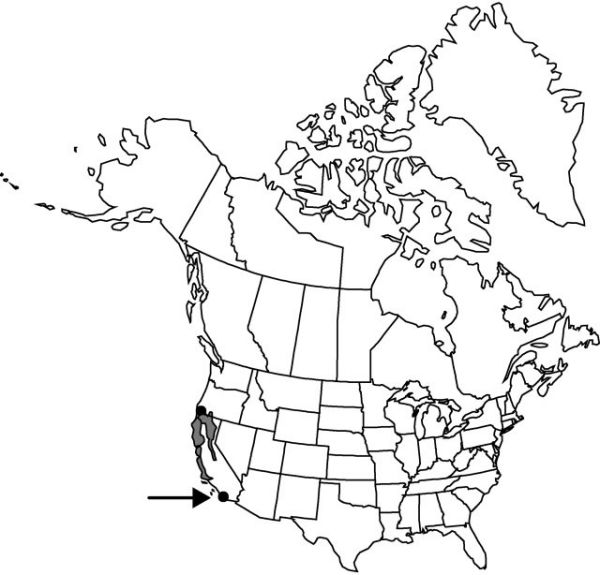Difference between revisions of "Lilium pardalinum"
Hesperian (San Francisco) 3: 300. 1859.
FNA>Volume Importer |
imported>Volume Importer |
||
| (2 intermediate revisions by 2 users not shown) | |||
| Line 6: | Line 6: | ||
|place=3: 300. 1859 | |place=3: 300. 1859 | ||
|year=1859 | |year=1859 | ||
| + | }} | ||
| + | |special_status={{Treatment/ID/Special_status | ||
| + | |code=F | ||
| + | |label=Illustrated | ||
| + | }}{{Treatment/ID/Special_status | ||
| + | |code=E | ||
| + | |label=Endemic | ||
}} | }} | ||
|basionyms= | |basionyms= | ||
| Line 81: | Line 88: | ||
|publication title=Hesperian (San Francisco) | |publication title=Hesperian (San Francisco) | ||
|publication year=1859 | |publication year=1859 | ||
| − | |special status= | + | |special status=Illustrated;Endemic |
| − | |source xml=https:// | + | |source xml=https://bitbucket.org/aafc-mbb/fna-data-curation/src/2e0870ddd59836b60bcf96646a41e87ea5a5943a/coarse_grained_fna_xml/V26/V26_319.xml |
|genus=Lilium | |genus=Lilium | ||
|species=Lilium pardalinum | |species=Lilium pardalinum | ||
Latest revision as of 21:14, 5 November 2020
Bulbs rhizomatous, usually branching, continuously scaly, 1.4–5.1 × 3.9–19 cm, 0.2–0.6 times taller than long; scales sometimes unsegmented but always some 2–4-segmented on each bulb, longest 1–3.3 cm; stem roots absent. Stems to 2.8 m, strongly clonal and thus forming dense colonies, to weakly clonal and forming small colonies or clumps. Buds rounded in cross section. Leaves usually ± evenly distributed along stem, rarely concentrated proximally, scattered or in 1–6 whorls or partial whorls, 3–19 leaves per whorl, horizontal and drooping at tips to ascending, 4.9–26.5 × 0.3–5.6 cm, 3–34 times longer than wide; blade usually ± elliptic, wide or narrow, margins usually not undulate, apex acute, often narrowly so; veins and margins ± smooth abaxially. Inflorescences racemose, 1–28(–35)-flowered. Flowers pendent, usually not fragrant; perianth Turk’s-cap-shaped; sepals and petals reflexed 1/4–1/3 along length from base, yellow, yellow-orange, or orange proximally, darker orange to red-orange to red on distal 1/5–3/5 (entirely orange or yellow-orange in subsp. wigginsii), with maroon spots concentrated proximally and always surrounded by yellow or orange if extending into distal reddish zone, conspicuously green abaxially on proximal ± 1/5, not distinctly clawed; sepals not ridged abaxially, 3.5–10.4 × 0.9–2.2 cm; petals 3.4–10.2 × 0.9–2.5 cm; stamens moderately to strongly exserted; filaments moderately to widely spreading, diverging 7°–22° from axis; anthers ± magenta or sometimes orange, orange-pink, or pale yellow, 0.5–2.2 cm; pollen red-brown, red-orange, brown-orange, rust, orange, or yellow; pistil 3.1–7.5 cm; ovary 1–2.2 cm; style green, often pale, rarely sordid; pedicel 6–32 cm. Capsules 2.2–5.7 × 1.2–2.1 cm, 1.5–3.7 times longer than wide. Seeds 123–264.
Distribution

Calif., Oreg.
Discussion
Subspecies 5 (5 in the flora).
The subspecies of Lilium pardalinum display a classic pattern of discrete geographical ranges with intervening zones of introgression, and no two occur sympatrically without intermixing. Plants in the hybrid zones are confusing in appearance and cannot be assigned to subspecies. However, each subspecies is fairly well marked within its core distribution. With the exception of subsp. pitkinense, the subspecies of L. pardalinum can be common plants in the proper habitats within their rather narrow distributions.
Leaf size and shape are quite variable in Lilium pardalinum subspecies and often clearly dependent on environment. In populations that typically have narrow, ascending leaves, shaded plants often have wide, horizontal leaves. This hampers taxonomic separation as well as identification, especially of herbarium specimens. Further field study is desirable.
Lilium pardalinum is primarily pollinated by western tiger swallowtails (Papilio rutulus Lucas, family Papilionidae) and pale swallowtails (P. eurymedon Lucas); several species of hummingbirds (family Trochilidae) are also important visitors, especially when butterflies are rare.
The Atsugewi, Karok, and Yana ate Lilium pardalinum bulbs steamed or baked in an earth oven (D. E. Moerman 1986).
Selected References
None.
Lower Taxa
Key
| 1 | Sepals and petals uniformly yellow or yellow-orange; sepals 3.5–7.1 cm; anthers pale yellow, 0.5–1.3 cm; pollen yellow or orange; pistil 3.1–4.3 cm; capsules 2.3–4.2 cm; n California, s Oregon. | Lilium pardalinum subsp. wigginsii |
| 1 | Sepals and petals ± 2-toned, with yellow or orange proximally, distal 1/5–3/5 darker orange to red; sepals 3.7–10.4 cm; anthers magenta, occasionally purple or orange, 0.5–2.2 cm; pollen yellow to rust; pistil 3.3–7.5 cm; capsules 2.2–5.7 cm; California, s Oregon. | > 2 |
| 2 | Sepals (5.9–)6.6–10.4 cm; anthers 1.1–2.2 cm; capsules 2.9–5.7 cm; leaves 3–12 times longer than wide, blade ± elliptic; stems strongly clonal, forming large colonies; California. | Lilium pardalinum subsp. pardalinum |
| 2 | Sepals 3.7–8.3 cm; anthers 0.5–1.8 cm; capsules 2.2–4.8 cm; leaves 3–34 times longer than wide, blade elliptic to linear; stems weakly to moderately clonal, sometimes forming small colonies; n California, s Oregon. | > 3 |
| 3 | Leaves 7.3–34 times longer than wide, often concentrated proximally, often ascending, sometimes horizontal, blade ± linear; sepals (4.9–)5.3–8.3 cm; anthers 0.6–1.8 cm; pollen usually dark orange; extreme nw California, adjacent s Oregon. | Lilium pardalinum subsp. vollmeri |
| 3 | Leaves 3–17 times longer than wide, ± evenly distributed along stem, ± ascending or horizontal, blade ± elliptic; sepals 3.7–7.6 cm; anthers 0.5–1.4 cm; pollen yellow, orange, or red- or brown-orange; n California, s Oregon. | > 4 |
| 4 | Pollen red- or brown-orange; anthers magenta; bulb scales usually 2-segmented; n Coast Ranges near Sebastopol, California. | Lilium pardalinum subsp. pitkinense |
| 4 | Pollen usually yellow or bright orange; anthers orange to magenta; bulb scales (1–)2–4-segmented; ne California, adjacent s Oregon. | Lilium pardalinum subsp. shastense |